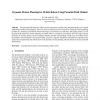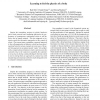265 search results - page 24 / 53 » Learning to Drive and Simulate Autonomous Mobile Robots |
ISRR
2005
Springer
14 years 1 months ago
2005
Springer
A novel model for dynamic emergence and adaptation of embodied behavior is proposed. A musculo-skeletal system is controlled by a number of chaotic elements, each of which driving...
ICRA
2007
IEEE
14 years 2 months ago
2007
IEEE
— We introduce an algorithm which detects and traces a specified level set of a scalar field (a contour) on a plane. A network of static sensor nodes with limited communication...
AROBOTS
2002
13 years 7 months ago
2002
The potential field method is widely used for autonomous mobile robot path planning due to its elegant mathematical analysis and simplicity. However, most researches have been focu...
CRV
2006
IEEE
13 years 11 months ago
2006
IEEE
In this paper we discuss landmark based absolute localization of tiny autonomous mobile robots in a known environment. Landmark features are naturally occurring as it is not allow...
CIMCA
2005
IEEE
14 years 1 months ago
2005
IEEE
Despite the tremendous progress in robotic hardware and in both sensorial and computing efficiencies the performance of contemporary autonomous robots is still far below that of ...


